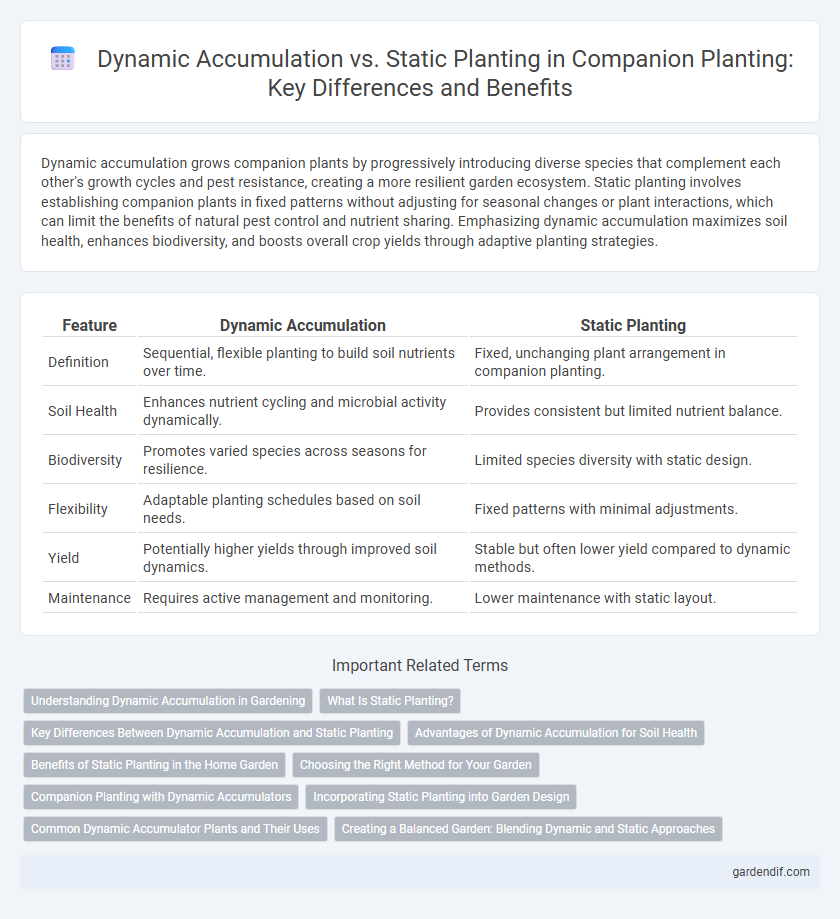
Dynamic accumulation vs static planting Illustration
Dynamic accumulation grows companion plants by progressively introducing diverse species that complement each other's growth cycles and pest resistance, creating a more resilient garden ecosystem. Static planting involves establishing companion plants in fixed patterns without adjusting for seasonal changes or plant interactions, which can limit the benefits of natural pest control and nutrient sharing. Emphasizing dynamic accumulation maximizes soil health, enhances biodiversity, and boosts overall crop yields through adaptive planting strategies.
Table of Comparison
| Feature | Dynamic Accumulation | Static Planting |
|---|---|---|
| Definition | Sequential, flexible planting to build soil nutrients over time. | Fixed, unchanging plant arrangement in companion planting. |
| Soil Health | Enhances nutrient cycling and microbial activity dynamically. | Provides consistent but limited nutrient balance. |
| Biodiversity | Promotes varied species across seasons for resilience. | Limited species diversity with static design. |
| Flexibility | Adaptable planting schedules based on soil needs. | Fixed patterns with minimal adjustments. |
| Yield | Potentially higher yields through improved soil dynamics. | Stable but often lower yield compared to dynamic methods. |
| Maintenance | Requires active management and monitoring. | Lower maintenance with static layout. |
Understanding Dynamic Accumulation in Gardening
Dynamic accumulation in gardening refers to plants' ability to actively gather and concentrate nutrients and minerals from the soil, improving overall soil fertility over time. This process contrasts with static planting, where plants typically do not enhance soil nutrient content but rather maintain existing conditions. Understanding dynamic accumulation enables gardeners to select companion plants that naturally replenish essential nutrients, promoting healthier growth and sustainable garden ecosystems.
What Is Static Planting?
Static planting refers to the fixed arrangement of companion plants in a predetermined layout that remains unchanged throughout the growing season. This method allows for consistent spatial relationships between crops and companions, optimizing benefits such as pest control, nutrient sharing, and microclimate regulation. Static planting techniques are often employed in permaculture and traditional gardening where stability and predictability are prioritized over flexibility.
Key Differences Between Dynamic Accumulation and Static Planting
Dynamic accumulation involves continuous nutrient uptake and redistribution within plants, enhancing soil fertility and promoting biodiversity, while static planting relies on fixed crops with limited nutrient cycling and reduced adaptability to environmental changes. Dynamic systems often integrate multiple species that facilitate nutrient exchange, improving ecosystem resilience compared to monoculture static planting. The key differences lie in nutrient flow efficiency, species diversity, and long-term soil health impact, with dynamic accumulation fostering sustainable growth and static planting risking soil depletion.
Advantages of Dynamic Accumulation for Soil Health
Dynamic accumulation enhances soil health by promoting biodiversity through diverse root exudates that stimulate microbial activity and nutrient cycling. This method improves soil structure and increases organic matter content, leading to greater water retention and erosion resistance compared to static planting. The continuous nutrient replenishment from dynamic accumulation supports sustainable crop growth and long-term soil fertility.
Benefits of Static Planting in the Home Garden
Static planting in the home garden enhances soil stability and reduces erosion by maintaining consistent plant cover, which supports beneficial microbial activity and nutrient retention. This method simplifies garden management through predictable plant placement, facilitating efficient watering and pest control practices. Home gardeners gain long-term health improvements in soil structure and fertility, promoting sustainable plant growth without frequent replanting disturbances.
Choosing the Right Method for Your Garden
Dynamic accumulation enhances soil fertility through diverse plant interactions that boost nutrient cycling and organic matter, making it ideal for gardens aiming for long-term sustainability. Static planting relies on fixed crop arrangements, which simplifies maintenance but may limit soil health improvement and biodiversity. Selecting the appropriate companion planting method depends on garden goals, soil conditions, and desired ecosystem benefits.
Companion Planting with Dynamic Accumulators
Companion planting with dynamic accumulators enhances soil fertility by using plants that mine essential nutrients from deep soil layers, making them available to neighboring crops. Dynamic accumulators like comfrey and borage accumulate minerals such as potassium, calcium, and magnesium, improving nutrient cycling and promoting healthier plant growth compared to static planting methods. Integrating these plants strategically in garden ecosystems supports sustainable agriculture and reduces reliance on synthetic fertilizers.
Incorporating Static Planting into Garden Design
Incorporating static planting into garden design enhances biodiversity by establishing permanent plantings that support soil health and pollinator habitats year-round. Static planting creates a stable ecological foundation, allowing companion plants to thrive by reducing competition and fostering symbiotic relationships. Combining static planting with dynamic accumulation techniques maximizes garden resilience and productivity through continuous ground cover and nutrient cycling.
Common Dynamic Accumulator Plants and Their Uses
Common dynamic accumulator plants such as comfrey, nettle, and dandelion actively mine nutrients from deep soil layers, enriching the upper soil horizon with essential minerals like potassium, calcium, and nitrogen. Unlike static planting which maintains the same crop or plant species year-round, dynamic accumulation involves growing these nutrient-accumulating plants to improve soil fertility and support companion planting strategies. These plants also provide organic matter that boosts microbial activity, promotes healthier crop yields, and reduces the need for synthetic fertilizers.
Creating a Balanced Garden: Blending Dynamic and Static Approaches
Creating a balanced garden involves blending dynamic accumulation techniques with static planting to enhance biodiversity and resilience. Dynamic accumulation uses nutrient-accumulating plants to improve soil fertility over time, while static planting maintains consistent crops for stability and structure. Combining these methods optimizes plant health, soil quality, and sustainable growth in companion planting systems.
Dynamic accumulation vs static planting Infographic

 gardendif.com
gardendif.com